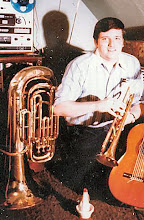1959 Coral Records CRL 757200 Stereo / CRL 57200 Mono
Side One
1. When My Baby Smiles At Me
2. Summertime
3. If I Had You
4. La Vie En Rose
5. On The Alamo
6. Tiger Rag
Side Two
1. I Want A Girl (Just Like The Girl That Married Dear Old Dad)
2. Dancing In The Dark
3. My Blue Heaven
4. That Old Feeling
5. I'm Looking Over A Four Leaf Clover
6. Hindustan
Liner Notes:
It was in the Fall of 1956 that three New Orleans musicians journeyed to the West Coast for the annual Gene Norman-Frank Bull Jazz Festival. They were veteran trumpet-man Al Hirt; a fourteen-year-old phenomenon on trumpet, Warren Luning, Jr.; and another veteran from the New Orleans jazz scene, clarinetist Pete Fountain. Among those in the audience that proceeded to flip over the playing of the New Orleans visitors was young Lawrence Welk, Jr. Forthwith he goes to the old man and says, "Dad, this you've gotta hear!" (Or words of similar import.) So Larry, Sr. put down his accordion, turned off the bubble-machine, and made the trip to the auditorium where the jazz bash was being held; and that night an idea was born. To wit: why not build a dixieland contingent from the Welk Orchestra around Pete Fountain, and feature him regularly, both at the dance sessions and on the weekly television broadcasts?
Thus it was that Pete Fountain left Al Hirt's band a few months after their return to New Orleans to accept an offer from Lawrence Welk that was (in Pete's words) "too good to turn down." It wasn't an easy decision to make, however, as Pete's father (the family name is Fontaine, the French for "fountain") had played drums and violin in New Orleans and along the Gulf Coast - and Pete had grown up in the dixieland tradition even before he started playing clarinet in a school band when he was twelve years old.
By the time he was in his late 'teens he was playing with a Junior Dixieland Band that was featured regularly at Tony Almerico's Sunday afternoon sessions at the Parisian Room on Royal Street; and eventually became a member of the regular band there. In big demand by the customers were the specialty numbers featuring Pete Fountain and his Three Coins - clarinet and rhythm. Other New Orleans bands with which Pete has played were Phil Zito's band (he recorded with this group for a major label when he was nineteen) and a cooperative group, The Basin Street Six. It was with the latter outfit that he made several trips to Chicago for engagements at such top spots as The Blue Note and Jazz Limited.
The heart of dixieland music, of course, is improvisation; and as a result, Pete didn't find it necessary to be able to read music with any degree of proficiency. Rather, he was more interested in improving his technique and ability to get around on his horn - and in listening to records featuring Irving Fazola (his idol on clarinet), and those featuring tenor-saxophonist Eddie Miller. (Pete plays fine tenor, too.) "Faz" and Eddie, like Pete, were born and raised in "The Cradle of Jazz", as New Orleans has been called. Although Pete admittedly has been strongly influenced by Fazola, there are times when I've heard him swinging like mad on some up-tempo thing and I'm reminded of Goodman; and on the other hand, on a soft, pretty number I sometimes hear a touch of Shaw in his warm, liquid tone - even in the upper register. For example, in "Dancing In The Dark."
Since joining the Lawrence Welk Orchestra as a featured soloist, Pete has taken advantage of the opportunity to study on the west coast - an opportunity which the mature Pete Fountain realized was a valuable one in keeping with his desire to grow musically. He is almost twenty-eight years old - his birthday being the day before Louis Armstrong's, but Pete was born thirty years after Louis, on July 3, 1930.
Although it is essentially the Welk Orchestra backing Pete in this album, the arrangements are not of the "Champagne Music" style, but were written especially for the session. Neither is it a jazz album. Rather it is designed for dancing, with an easily identifiable beat, and tempos well-suited for dancing. Only two of the selections, "Tiger Rag" and "Hindustan," are usually associated with typical dixieland fare. There are echoes of yesteryear in the Ted Lewis-like "wah-wah" on "When My Baby Smiles At Me," and "I Want A Girl;" a hint of the French influence in New Orleans, and Fountain's own lineage in "La Vie En Rose;" and the familiar and always-welcome standards "On The Alamo", "Summertime", and "My Blue Heaven."
So tell your friends to hop in the new Dodge (plug!) and come on over for a bit of dancing - and some mighty pleasant listening!
Dick Martin
(Station WWL, New Orleans)




No comments:
Post a Comment